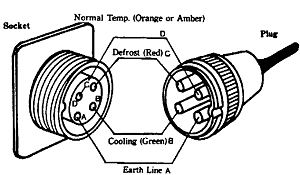With the four-wire monitoring system, a separate monitoring cable with four wires is used to record the status messages "Compressor running", "Defrost" and "Temperature in Range". Around 50-70% of all refrigerated containers have a socket to connect them to this type of monitoring system.
 |
Figure 19: Four-wire socket and plug |
With the power cable transmission (PCT) system, however, data is transmitted via the three-phase power cable of the containers. This enables an unlimited amount of data to be transmitted between the container and the receiver on board or on land. The data can be exchanged in both directions, so that it is also possible, for instance, to change the nominal value of the temperature of a container in this way. What is particularly significant in terms of its cost-saving potential is the option of making remote pre-trip inspections (PTI) of the containers on board or in the terminal, as well as to read out data logger information after a journey.
Two different variants of the PCT system are also currently available: Narrowband transmission, which operates at a fixed frequency to modulate data upon the power supply system, and wideband transmission, in which data is transmitted in a frequency spectrum. Unfortunately, the two systems are not compatible with each other, which means that they have to be installed on board depending on the equipment on the containers to be able to communicate with all containers. Out of approximately 360,000 integral refrigerated containers worldwide in 1997, approximately 24,000 (= approximately 6.6%) were equipped with narrowband modems and approximately 19,000 (= approximately 5.3%) with wideband modems. Which of these is used depends very much on the shipping line and the route.
It is expected that it will be possible to transmit data by radio frequency in the future, e.g. using "wireless LAN" technology.